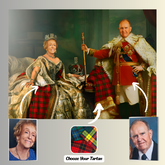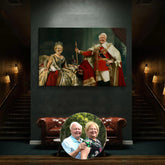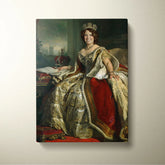-
Personalized Clan Blane 2 Tartan Drummer Ornament with Custom Name – Scottish Christmas Tree Decoration JD48
Personalized Clan Blane 2 Tartan Drummer Ornament with Custom Name – Scottish Christmas Tree Decoration JD48Celebrate your Scottish heritage with this unique wood & acrylic tartan ornament. Perfect as a personalized Christmas decoration or a meaningful gift for friends and relatives on special occasions...- From $19.99 USD
$25.99 USD- From $19.99 USD
- Unit price
- per
Save $6.00 -
Personalized Clan Blane 1 Tartan Drummer Ornament with Custom Name – Scottish Christmas Tree Decoration IC18
Personalized Clan Blane 1 Tartan Drummer Ornament with Custom Name – Scottish Christmas Tree Decoration IC18Celebrate your Scottish heritage with this unique wood & acrylic tartan ornament. Perfect as a personalized Christmas decoration or a meaningful gift for friends and relatives on special occasions...- From $19.99 USD
$25.99 USD- From $19.99 USD
- Unit price
- per
Save $6.00 -
Personalized Clan Strathblane Reproduction Tartan Bagpipe Ornament with Custom Name – Scottish Christmas Tree Decoration QW18
Personalized Clan Strathblane Reproduction Tartan Bagpipe Ornament with Custom Name – Scottish Christmas Tree Decoration QW18Celebrate your Scottish heritage with this unique wood & acrylic tartan ornament. Perfect as a personalized Christmas decoration or a meaningful gift for friends and relatives on special occasions...- From $19.99 USD
$25.99 USD- From $19.99 USD
- Unit price
- per
Save $6.00 -
Personalized Clan Strathblane Modern Tartan Bagpipe Ornament with Custom Name – Scottish Christmas Tree Decoration TY97
Personalized Clan Strathblane Modern Tartan Bagpipe Ornament with Custom Name – Scottish Christmas Tree Decoration TY97Celebrate your Scottish heritage with this unique wood & acrylic tartan ornament. Perfect as a personalized Christmas decoration or a meaningful gift for friends and relatives on special occasions...- From $19.99 USD
$25.99 USD- From $19.99 USD
- Unit price
- per
Save $6.00 -
Personalized Clan Strathblane Ancient Tartan Bagpipe Ornament with Custom Name – Scottish Christmas Tree Decoration SY65
Personalized Clan Strathblane Ancient Tartan Bagpipe Ornament with Custom Name – Scottish Christmas Tree Decoration SY65Celebrate your Scottish heritage with this unique wood & acrylic tartan ornament. Perfect as a personalized Christmas decoration or a meaningful gift for friends and relatives on special occasions...- From $19.99 USD
$25.99 USD- From $19.99 USD
- Unit price
- per
Save $6.00 -
Personalized Clan Dunblane District Reproduction Tartan Bagpipe Ornament with Custom Name – Scottish Christmas Tree Decoration JU23
Personalized Clan Dunblane District Reproduction Tartan Bagpipe Ornament with Custom Name – Scottish Christmas Tree Decoration JU23Celebrate your Scottish heritage with this unique wood & acrylic tartan ornament. Perfect as a personalized Christmas decoration or a meaningful gift for friends and relatives on special...- From $19.99 USD
$25.99 USD- From $19.99 USD
- Unit price
- per
Save $6.00 -
Personalized Clan Dunblane District Modern Tartan Bagpipe Ornament with Custom Name – Scottish Christmas Tree Decoration DN39
Personalized Clan Dunblane District Modern Tartan Bagpipe Ornament with Custom Name – Scottish Christmas Tree Decoration DN39Celebrate your Scottish heritage with this unique wood & acrylic tartan ornament. Perfect as a personalized Christmas decoration or a meaningful gift for friends and relatives on special...- From $19.99 USD
$25.99 USD- From $19.99 USD
- Unit price
- per
Save $6.00 -
Personalized Clan Dunblane District Ancient Tartan Bagpipe Ornament with Custom Name – Scottish Christmas Tree Decoration FZ93
Personalized Clan Dunblane District Ancient Tartan Bagpipe Ornament with Custom Name – Scottish Christmas Tree Decoration FZ93Celebrate your Scottish heritage with this unique wood & acrylic tartan ornament. Perfect as a personalized Christmas decoration or a meaningful gift for friends and relatives on special...- From $19.99 USD
$25.99 USD- From $19.99 USD
- Unit price
- per
Save $6.00 -
Personalized Clan Blane 2 Tartan Bagpipe Ornament with Custom Name – Scottish Christmas Tree Decoration NS63
Personalized Clan Blane 2 Tartan Bagpipe Ornament with Custom Name – Scottish Christmas Tree Decoration NS63Celebrate your Scottish heritage with this unique wood & acrylic tartan ornament. Perfect as a personalized Christmas decoration or a meaningful gift for friends and relatives on special occasions...- From $19.99 USD
$25.99 USD- From $19.99 USD
- Unit price
- per
Save $6.00 -
Personalized Clan Blane 1 Tartan Bagpipe Ornament with Custom Name – Scottish Christmas Tree Decoration PC42
Personalized Clan Blane 1 Tartan Bagpipe Ornament with Custom Name – Scottish Christmas Tree Decoration PC42Celebrate your Scottish heritage with this unique wood & acrylic tartan ornament. Perfect as a personalized Christmas decoration or a meaningful gift for friends and relatives on special occasions...- From $19.99 USD
$25.99 USD- From $19.99 USD
- Unit price
- per
Save $6.00 -
Personalized Clan Blane 2 Tartan Bagpipe Ornament with Custom Name – Scottish Christmas Tree Decoration AA31
Personalized Clan Blane 2 Tartan Bagpipe Ornament with Custom Name – Scottish Christmas Tree Decoration AA31Celebrate your Scottish heritage with this unique wood & acrylic tartan ornament. Perfect as a personalized Christmas decoration or a meaningful gift for friends and relatives on special occasions...- From $19.99 USD
$25.99 USD- From $19.99 USD
- Unit price
- per
Save $6.00 -
Personalized Clan Blane 1 Tartan Bagpipe Ornament with Custom Name – Scottish Christmas Tree Decoration ZW16
Personalized Clan Blane 1 Tartan Bagpipe Ornament with Custom Name – Scottish Christmas Tree Decoration ZW16Celebrate your Scottish heritage with this unique wood & acrylic tartan ornament. Perfect as a personalized Christmas decoration or a meaningful gift for friends and relatives on special occasions...- From $19.99 USD
$25.99 USD- From $19.99 USD
- Unit price
- per
Save $6.00 -
Personalized Clan Blane Clan Crest Tartan Santa Ornament – Custom Acrylic Christmas Decoration VZ30 - Blane
Personalized Clan Blane Clan Badge Tartan Ornament – Custom Acrylic Christmas Decoration VZ30Celebrate your Scottish heritage with this unique wood & acrylic tartan ornament. Perfect as a personalized Christmas decoration or a meaningful gift for friends and relatives on special occasions such as Christmas,...- From $19.99 USD
- From $19.99 USD
- Unit price
- per
-
Blane
-
Personalized Clan Blane Clan Crest Tartan Santa Ornament – Custom Acrylic Christmas Decoration ZX54 - Blane
Personalized Clan Blane Clan Badge Tartan Ornament – Custom Acrylic Christmas Decoration ZX54Celebrate your Scottish heritage with this unique wood & acrylic tartan ornament. Perfect as a personalized Christmas decoration or a meaningful gift for friends and relatives on special occasions such as Christmas,...- From $19.99 USD
- From $19.99 USD
- Unit price
- per
-
Blane
-
Custom Name Clan Blane 2 Tartan Garden Flag with Clan Crest and the Golden Sword of Courageous Legacy MI73 - Blane 2
Custom Name Clan Blane 2 Tartan Garden Flag with Clan Crest and the Golden Sword of Courageous Legacy MI73 Immerse your space in the rich heritage of Scotland with our Tartan Garden Flags, exclusively from Tartan Today. Featuring vibrant tartan and Scottish heritage designs, these...- From $34.45 USD
- From $34.45 USD
- Unit price
- per
-
Blane 2
-
Custom Name Clan Blane 1 Tartan Garden Flag with Clan Crest and the Golden Sword of Courageous Legacy YL57 - Blane 1
Custom Name Clan Blane 1 Tartan Garden Flag with Clan Crest and the Golden Sword of Courageous Legacy YL57 Immerse your space in the rich heritage of Scotland with our Tartan Garden Flags, exclusively from Tartan Today. Featuring vibrant tartan and Scottish heritage designs, these...- From $34.45 USD
- From $34.45 USD
- Unit price
- per
-
Blane 1
-
Clan Blane 2 Tartan Scotland Map Canvas “Tartan Runs Through My Veins” Wall Art IN88
Clan Blane 2 Tartan Scotland Map Canvas “Tartan Runs Through My Veins” Wall Art IN88Celebrate your Scottish heritage with this striking canvas print featuring the map of Scotland filled with Blane 2 tartan, paired with the bold phrase: “Tartan Runs Through My Veins.” Whether...- From $35.05 USD
- From $35.05 USD
- Unit price
- per
-
Clan Blane 1 Tartan Scotland Map Canvas “Tartan Runs Through My Veins” Wall Art DL92
Clan Blane 1 Tartan Scotland Map Canvas “Tartan Runs Through My Veins” Wall Art DL92Celebrate your Scottish heritage with this striking canvas print featuring the map of Scotland filled with Blane 1 tartan, paired with the bold phrase: “Tartan Runs Through My Veins.” Whether...- From $35.05 USD
- From $35.05 USD
- Unit price
- per
-
Personalized Clan Blane 2 Tartan Shirt with Scotland Coat of Arms & Custom Name VL65 - Blane 2
Blane 2 Tartan Shirt with Scotland Coat of Arms & Custom Name VL65Celebrate your Scottish heritage with this Blane 2 Tartan Shirt with Scotland Coat of Arms & Custom Name VL65, featuring a bold Scotland Coat of Arms and your custom name on the...- From $39.54 USD
- From $39.54 USD
- Unit price
- per
-
Blane 2
-
Personalized Clan Blane 1 Tartan Shirt with Scotland Coat of Arms & Custom Name QA81 - Blane 1
Blane 1 Tartan Shirt with Scotland Coat of Arms & Custom Name QA81Celebrate your Scottish heritage with this Blane 1 Tartan Shirt with Scotland Coat of Arms & Custom Name QA81, featuring a bold Scotland Coat of Arms and your custom name on the...- From $39.54 USD
- From $39.54 USD
- Unit price
- per
-
Blane 1
Ex: Your Tartan + Product
Popular Products
Turn Me Royal Personalized Portrait from Your Photo, Custom Tartan. Custom Canvas Wall Art as Gift for Men
- From $32.45 USD
- From $32.45 USD
- Unit price
- / per
Royalty Couple Personalized Portrait from Your Photo, Custom Tartan. Custom Canvas Wall Art
- From $47.45 USD
- From $47.45 USD
- Unit price
- / per
The Queen Personalized Portrait from Your Photo, Custom Tartan. Custom Canvas Wall Art as Gift for Women
- From $32.45 USD
- From $32.45 USD
- Unit price
- / per
Which Clan Are You From?
List Of Tartan
-
Clan A
- Abercrombie Tartan
- Aberdeen Tartan
- Abernethy Tartan
- Adair Tartan
- Adam Tartan
- Ayrshire Tartan
- Agnew Tartan
- Aikenhead Tartan
- Ainslie Tartan
- Aiton Tartan
- Allan Tartan
- Alexander Tartan
- Allardice Tartan
- Allison Tartan
- Anderson Tartan
- Angus Tartan
- Anstruther Tartan
- Arbuthnot Tartan
- Armstrong Tartan
- Arnott Tartan
- Auchinleck Tartan
- Ayrshire Tartan
-
Clan B
- Baillie Tartan
- Bain Tartan
- Baird Tartan
- Balfour Tartan
- Bannatyne Tartan
- Bannerman Tartan
- Barclay Tartan
- Baxter Tartan
- Beaton Tartan
- Bell Tartan
- Belshes Tartan
- Bethune Tartan
- Beveridge Tartan
- Binning Tartan
- Bisset Tartan
- Blackadder Tartan
- Blackstock Tartan
- Black Watch Tartan
- Blair Tartan
- Blane Tartan
- Blyth Tartan
- Borthwick Tartan
- Boswell Tartan
- Bowie Tartan
- Boyd Tartan
- Boyle Tartan
- Brisbane Tartan
- Brodie Tartan
- Brown/ Broun Tartan
- Bruce Tartan
- Buccleuch Tartan
- Buchan Tartan
- Buchanan Tartan
- Burnett Tartan
- Burns Tartan
- Butter Tartan
- Byres Tartan
-
Clan C
- Cairns Tartan
- Calder Tartan
- Callander Tartan
- Cameron Tartan
- Campbell Tartan
- Campbell of Breadalbane Tartan
- Campbell of Cawdor Tartan
- Carmichael Tartan
- Carnegie Tartan
- Carruthers Tartan
- Cathcart Tartan
- Chalmers Tartan
- Charteris Tartan
- Chattan Tartan
- Cheyne Tartan
- Chisholm Tartan
- Christie Tartan
- Clark Tartan
- Clelland Tartan
- Clephan Tartan
- Clergy Tartan
- Cochrane Tartan
- Cockburn Tartan
- Colquhoun Tartan
- Colville Tartan
- Cooper Tartan
- Couper Tartan
- Craig Tartan
- Cranstoun Tartan
- Crawford Tartan
- Crichton Tartan
- Crief District Tartan
- Crosbie Tartan
- Cumming Tartan
- Cunningham Tartan
- Currie Tartan
- Clan D
- Clan E
- Clan F
- Clan G
- Clan H
- Clan I
- Clan J
- Clan K
- Clan L
-
Clan M
- Maitland Tartan
- Malcolm Tartan
- Mar Tartan
- Marjoribanks Tartan
- Maxtone Tartan
- Matheson Tartan
- Maule Tartan
- Maxwell Tartan
- Meldrum Tartan
- Melville Tartan
- Menzies Tartan
- Mercer Tartan
- Middleton Tartan
- Moffat Tartan
- Moncrieffe Tartan
- Montgomery Tartan
- Monypenny Tartan
- Moncreiffe Tartan
- Monteith Tartan
- Morrison Tartan
- Mouat Tartan
- Moubray Tartan
- Mow Tartan
- Muir_More Tartan
- Muirhead Tartan
- Munro Tartan
- Murray Tartan
- Murray of Atholl Tartan
-
Clan Mc/Mac
- MacAlister Tartan
- MacArthur Tartan
- MacAlpine Tartan
- MacAulay Tartan
- MacBain Tartan
- MacBean Tartan
- MacBeth Tartan
- MacCallum Tartan
- MacCraig Tartan
- MacColl Tartan
- MacCorquodale Tartan
- MacDiarmid Tartan
- MacDonald Tartan
- MacDonald of Clanranald Tartan
- MacDonald of Sleat Tartan
- MacDonnell of Glengarry Tartan
- MacDonnell of Keppoch Tartan
- MacDougall Tartan
- MacDowall Tartan
- MacDuff Tartan
- MacEwen_MacEwan Tartan
- MacEdward Tartan
- MacFarlane Tartan
- MacGill Tartan
- MacGillivray Tartan
- MacGregor Tartan
- MacGowan (McGowan) Tartan
- MacHardy Tartan
- MacIan Tartan
- MacInnes Tartan
- MacIntyre Tartan
- MacKay Tartan
- MacKillop Tartan
- MacKellar Tartan
- Mackinlay Tartan
- MacKenzie Tartan
- Mackie Tartan
- MacKinnon Tartan
- MacKintosh / MacIntosh Tartan
- MacLeod Tartan
- MacMillan Tartan
- MacNab Tartan
- MacNaughton Tartan
- MacNeil / MacNeill Tartan
- MacNeil of Colonsay Tartan
- MacNicol Tartan
- MacPhail Tartan
- MacPhee_MacFie Tartan
- MacPherson Tartan
- MacQuarrie Tartan
- MacQueen Tartan
- MacRae Tartan
- MacRow Tartan
- MacSporran Tartan
- MacTaggart Tartan
- MacTavish Tartan
- MacThomas Tartan
- McCorquodale Tartan
- McCulloch Tartan
- McFadzen Tartan
- McGeachie Tartan
- McIver Tartan
- McKerrell Tartan
- Clan N
- Clan O
- Clan P
- Clan R
-
Clan S
- Sandilands Tartan
- Scott Tartan
- Scrymgeour Tartan
- Selkirk Tartan
- Sempill Tartan
- Seton Tartan
- Shaw Tartan
- Shepherd Tartan
- Sinclair Tartan
- Skene Tartan
- Skirving Tartan
- Smith Tartan
- Somerville Tartan
- Spalding Tartan
- Spens Tartan
- Spottiswood Tartan
- Stevenson Tartan
- Stewart Tartan
- Stewart of Appin Tartan
- Stirling Tartan
- Strachan Tartan
- Straiton Tartan
- Strange Tartan
- Strathclyde District Tartan
- Stuart of Bute Tartan
- Sutherland Tartan
- Swinton Tartan
- Clan T
- Clan U W Y
- Request Your Clan
Clan Blane (Blane Tartan)
1. About Clan Blane (Blane Tartan)
2. Clan Blane History (Blane Tartan)
The name is a shortened version of MacBlain and is also used as Blain. found primarily in Wigtown and Ayr.
In 1561, Patrick Blane served as the provost of Wigtown, and in 1674, John Blain received a charter for half of the Meikle-Wig ten-merk estates in the parish of Whithorn.
In 1684, Agnes Blain appears in a parish record for Kirkudbright.
A charter given to the St. Cuthbert's monks at Coldingham by Robert, bishop of St. Andrews, was witnessed by Blahan, presbyter of Linton, East Lothian.
3. Clan Blane Tartans
Since there is no officially recognized Blane tartan, those who go by that name might don the Galloway District tartans, which honor the clan's historical location.
Galloway Red
Galloway District
4. Clan Blane Crest & Coats of Arms
4.1 Clan Blane Crest
Worn by all of the name and ancestry
4.2 Clan Blane Coat of Arms
Observations on coats of arms
With the exception of civic or corporate arms, a person is granted a coat of arms under Scottish heraldic law. A 'family coat of arms' does not exist.
With the exclusions listed above, the weapons depicted below are personal weapons. The only person authorized to use these weapons is the grantee.
Blane Arms
5. Clan Blane Places & People
5.1 Clan Blane People
Sir Gilbert Blane of Blanefield, 1st Baronet (1749 – 1834)
Scottish physician Gilbert Blane was. He was up in Ayrshire, near Blanefield, and attended Glasgow and Edinburgh Universities to study medicine. He relocated to London and treated Lord Rodney privately.
From there, he was appointed Physician to the Fleet and followed Rodney to the West Indies in 1779. All sailors were required to drink lemon juice to stave off scurvy thanks to his insistence on it.
Due to the lack of lemons in several Caribbean colonies, limes were substituted, and it is from this that the slang name "limey" (for a British person) originates.
In December 1784, Blane received the Royal Society's election as a Fellow. As the Prince of Wales, King George IV, and William IV's physician, he relocated to St. Thomas Hospital in 1783.
He developed during this time as a public health advocate and government consultant.
He was elevated to the rank of baronet in 1812. "Observations on the Diseases of Seamen" and "Elements of Medical Logic" are two of his published works.
Both Kirkoswald and Burghfield in Berkshire were Blane's homes. On June 26, 1834, he passed away in Piccadilly, London.
- Choosing a selection results in a full page refresh.













































